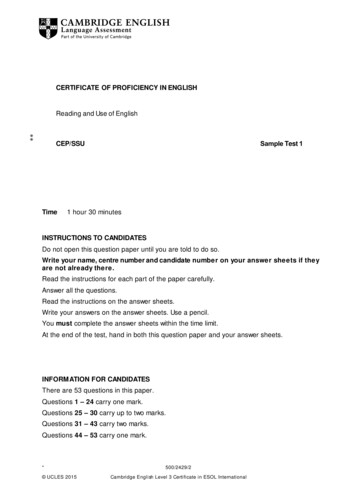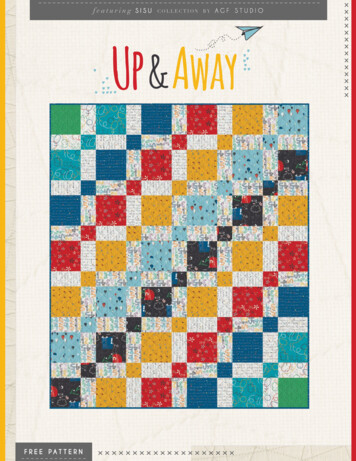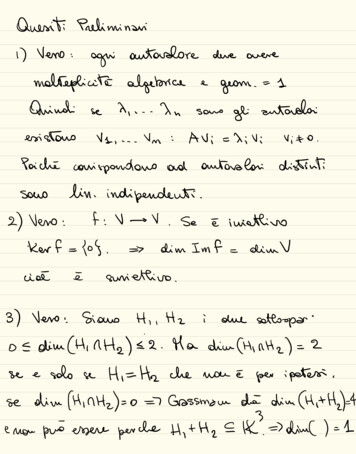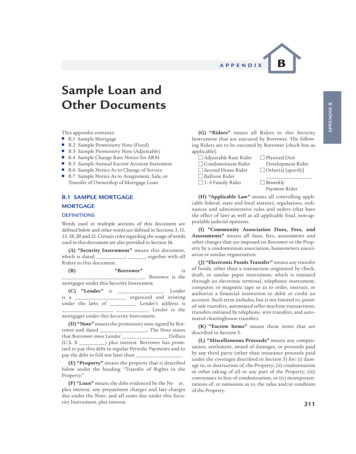
Transcription
CERTIFICATE OF PROFICIENCY IN ENGLISHReading and Use of English Sample Test 1CEP/SSUTime1 hour 30 minutesINSTRUCTIONS TO CANDIDATESDo not open this question paper until you are told to do so.Write your name, centre number and candidate number on your answer sheets if theyare not already there.Read the instructions for each part of the paper carefully.Answer all the questions.Read the instructions on the answer sheets.Write your answers on the answer sheets. Use a pencil.You must complete the answer sheets within the time limit.At the end of the test, hand in both this question paper and your answer sheets.INFORMATION FOR CANDIDATESThere are 53 questions in this paper.Questions 1 – 24 carry one mark.Questions 25 – 30 carry up to two marks.Questions 31 – 43 carry two marks.Questions 44 – 53 carry one mark.* UCLES 2015500/2429/2Cambridge English Level 3 Certificate in ESOL International
2Part 1For questions 1 – 8, read the text below and decide which answer (A, B, C or D) best fits each gap.Mark your answers on the separate answer sheet.There is an example at the beginning DVENTURE TRAVELWilfred Thesinger, the (0)Dexplorer once said, ‘We live our lives second-hand’. Sadly, his wordsare true for far too many of us, as we (1) . in front of the television, (2) . in ‘reality’television, living our adventures through the words and pictures of others. But it does not have to bethat way – there are more opportunities than ever for taking a break from our increasingly sanitisedlives and exploring not only some exotic (3) . of the globe, but also our own abilities andambitions. The kind of first-hand experience whose loss Thesinger laments is still available for anyonewilling to forsake the beaten (4) . , and put their mind to (5) . into the less exploredregions of this (6) . planet.The (7) . in travel in recent years has been towards what is known as adventure travel. Butadventure doesn’t have to involve physical exertion; be it haggling over a souvenir in Peru, or gettinglost in the labyrinthine passages of a Moroccan souk, it all (8) . .
CtrackDcourse5Aturning outBtaking offCmaking outDdropping CcustomDinclination8AfitsBbelongsCcountsDholdsTurn over
4Part 2For questions 9 – 16, read the text below and think of the word which best fits each space. Use onlyone word in each space. There is an example at the beginning (0). Write your answers IN CAPITALLETTERS on the separate answer sheet.Example:0I FMOBILE COMMUNICATIONFor many people, mobile email is a habit they couldn’t give up even (0)IFthey wanted to. And(9) . should they want to? (10) . . all, the ability to send and receive emails from a mobiledevice means they can stay in touch with colleagues, friends and family, whether they’re standing in aqueue at the supermarket, downing a quick cup of coffee in (11) . meetings or killing(12) . before a flight.It’s fair to say that access to email while (13) . the move has done much to whet appetites forother kinds of collaborative tools. What’s (14) . , there’s a whole new way of working that hasopened up in recent years and, (15) . . a result, there’s a general expectation that efficiency andproductivity don’t necessarily take (16) . within the four walls of an organisation’s physicaloffices.
5Part 3For questions 17 – 24, read the text below. Use the word given in capitals at the end of some of thelines to form a word that fits in the space in the same line. There is an example at the beginning (0).Write your answers IN CAPITAL LETTERS on the separate answer sheet.Example:0E F F E C T I V EPOWER NAPSPower napping is an (0)EFFECTIVE .strategy.It involves taking an intensesleep which dramatically improves (17) . , making it especially useful forEFFECTALERTthose with a demanding schedule such as mothers of babies or travellingbusiness (18) . . However, the conditions must be right and practice isEXECUTErequired to (19) . the effects.MAXIMUMTo prevent (20) . on awakening, power naps should last about 25ORIENTATEminutes. Falling asleep so quickly takes practice, but is in fact a habit which is(21) . easy to acquire. Initially, it is more important to relax for a whileCOMPAREthan actually fall asleep, and power-napping is not a good idea if you find itdifficult to wake up at the (22) . time.DESIGNFinally, power-napping should not be confused with the kind of dozing that can(23) . a sensation of overwhelming sleepiness during the day, whichCOMPANYsimply represents the (24) . experienced in the attempt to compensateDESPAIRfor a poor sleep routine.Turn over
6Part 4For questions 25 – 30, complete the second sentence so that it has a similar meaning to the firstsentence, using the word given. Do not change the word given. You must use betweenthree and eight words, including the word given. Here is an example (0).Example:Do you mind if I watch you while you paint?0objectionDo you you while you paint?have any objection to my watching0Write only the missing words on the separate answer sheet.25 It’s impossible to predict how long it will take to do this job.tellingThere is will take.26 Not many people buy that particular product these days.demandThere that particular product these days.27 For me, his skill as a negotiator was most impressive.howI was most negotiator he was.28 Nobody expected Natalia to resign.cameNatalia’s everyone.
729 The area was completely devoid of vegetation.whatsoeverThere the area.30 When he was at his most successful, the President had enormous influence.heightAt , the President had enormous influence.Turn over
8Part 5You are going to read an extract from a novel. For questions 31 – 36, choose the answer(A, B, C or D) which you think fits best according to the text. Mark your answers on the separateanswer sheet.Lucy gets a new job on a newspaperIt was a precarious period for her where her own fortunes were concerned. She had to rely on freelance work for sixmonths after the quality weekly magazine folded. The regular salary cheque had always seemed derisively small, butnow it was like lost riches. Doggedly, she wrote letters and telephoned and peppered editors with unsolicited articlesand suggestions. Sometimes she struck lucky and got a commission. She wrote a profile of a woman politician whoappreciated her fair-minded approach and tipped her off about a local government row in a complacent cathedraltown. Lucy went there, investigated, talked to people and wrote a piece exposing a rich cauldron of corruption whichwas snapped up by a national daily newspaper. This in turn led to a commission to investigate the controversial sitingof a theme park in the north of England. Her article was noticed by the features editor in search of something sharpand bracing on the heritage industry in general. She was getting a name for abrasive comment, for spotting an issueand homing in upon it. Anxiously, she scoured the press for hints of impending issues. In this trade, she saw, youneeded not so much to be abreast of things as ahead of them, lying in wait for circumstance, ready to pounce.But an article sold every week or two did not pay the bills. She began to contemplate, bleakly, a return to thetreadmill of proofreading and copy-editing. And then one day she walked into the offices of the national daily whichhad taken her cauldron of corruption piece and whose features editor had since looked kindly upon her. Havinghanded over a speculative piece on the latest educational theories she’d written, she fell into conversation with anacquaintance and learned that one of the paper’s regular columnists had fallen foul of the editor and departed in acloud of dust. The column, traditionally addressed to matters of the moment and written so as to provoke attentionand controversy, was untethered, so to speak. Lucy made the necessary phone call before her nerve went.She was asked to submit a piece as a trial run which they published. ‘Great,’ they said. ‘We’ll let you know,’ theysaid. ‘Soon,’ they assured her, ‘really very soon.’ She chewed her nails for a fortnight; a seasoned hack was given atrial run after her; she read his contribution which, she saw with absolute clarity, was succinct, incisive and original.Or just possibly anodyne, banal and plodding.And then, the phone call came. She’d have a weekly column with her own by-line and her photograph, postage-stampsize, next to it. There’d be a salary cheque, and perhaps fame and success to follow that. Thinking morepragmatically, she realised that the job presented her with not only a wonderful opportunity but also the inevitablepressure of keeping up with the twists and turns of events to which she must supply a perceptive commentary.‘A start,’ she said to her mother, Maureen, and Bruce, her step-father. ‘It’s a start anyway, but they could fire me atany moment.’‘Just let them try,’ said Maureen belligerently. ‘I think you’re better with your hair a bit shorter. Or maybe that’s nota very flattering picture. I think you’re very clever. You did some lovely essays at school. I wonder if I’ve still gotany of them somewhere.’Later, when she was alone, Lucy thought that her appointment had probably been a piece of good fortune. Sherefused to allow the word luck. She was young yet, and this was something of a plum. She must have got the job onher merits, she told herself, along with whatever assistance there may have been from the inadequacies of othersconsidered for the appointment, or the failure of further rivals to apply. What she was never to know was that in factthe editor had been on the verge of offering the column to the seasoned hack – had been about to pick up the phone –when the colleague he most disliked had walked into his office and spoken with satisfaction of the prospect of closerassociation with this old crony of his. The editor listened with some indignation, first at the assumption that thiswould be his decision, and then at the notion of these two ganging up under his nose. As soon as the colleague wasout of the room he reached for the phone. And rang Lucy.And so it began, that time during which she was so feverishly hitched to the affairs of public life that in retrospect itwas to seem as though she hurtled from day to day with the onward rush of the news, denied any of the lethargy ofindividual existence.
931After losing her job, how did Lucy feel about the salary she used to earn?ABCD32Lucy thinks the secret of success as a freelance journalist is toABCD33is forgetful and absent-minded.understands little about Lucy’s job.has good critical judgement about writing.expects Lucy will have trouble with the editor.On reflection, how did Lucy account for the fact that she got the job?ABCD36She had a friend who worked there.She had impressed the features editor.She had gained a reputation for effective reporting.She had discovered some information about a vacancy.It is suggested that Lucy’s mother MaureenABCD35keep yourself informed about current affairs.adopt a controversial style of writing.identify future newsworthy situations.make as many contacts as possible.What made Lucy decide to apply for a job on the national daily?ABCD34She had been foolish to give it up.It had given her a sense of security.She should have appreciated it more.It represented a fair return for her work.She hoped it was because she deserved it.She was unable to understand how it happened.She thought her age had given her an advantage.She knew she was better than the many applicants.The impression given of the editor is that he isABCDanxious to please his colleagues.unable to make up his mind.prone to act on impulse.quick to take offence.Turn over
10Part 6You are going to read an extract from an article. Seven paragraphs have been removed from theextract. Choose from the paragraphs A – H the one which fits each gap (37 – 43). There is one extraparagraph which you do not need to use. Mark your answers on the separate answer sheet.The fog catcher’s forestA bare, dusty island where the rain never falls could soon be covered with trees. Fred Pearce reports.When Spanish sailors landed in the Canary Islandsin the 15th century, they were amazed to discover anaboriginal population with extensive agriculturewhich they had somehow managed to sustain withvirtually no rainfall. Legend has it that the Guanchepeople derived all their water from a single largetree, which stripped moisture out of passing fogsand dripped enough water from its leaves to supporta thousand people. However true the story may be,there is no doubt that the only thing stopping theCanaries from resembling the Sahara desert, just 70kilometres to the east, is the moisture-rich fog thatdrifts in from the Atlantic Ocean.37Sometime in the last century, the last of the treeson high ground were cut down and the land began todry out. This meant that across much of thenorth of the island, agriculture went into decline.Now David Riebold, a forestry scientist-turnedschoolteacher who owns a home on the island, has aplan to reverse the trend. He wants to use artificialfog harvesting to bring back the cloud forest, inwhat promises to be the largest reforestation projectever attempted using the technology.38For years Riebold watched these failed efforts bylocal foresters. Then he read about a successfulresearch project in Chile which harvested the fogsthat regularly rolled in from the Atacama desert.Nets erected on a ridge facing the ocean providedenough water for a small town. Realising thatLanzarote’s climate was very similar to Chile’s,Riebold began to wonder whether fog harvestingcould be used to keep the saplings alive.39On paper, fog harvesting looked like a solution tothe island’s reforestation problems, but convincingthe authorities to give it a try wasn’t easy. For manyyears Riebold tried and failed to convince anyone toback his idea. It took the arrival of a new mayor tofinally get his scheme approved. ‘Proyecto David’,as the locals call it, got under way, and the townauthorities erected eight modest fog-collectingdevices on three of Lanzarote’s mountains.40This summer, having declared the initial experimenta success, the island council plans to install eightmuch larger devices which will discharge water intoa pumped drip irrigation network designed to keepthe saplings watered. Riebold hopes that this willform the pilot phase of a full-scale reforestation ofthe mountains of northern Lanzarote.41If the initial results scale up, a new cloud forestcould restore the island to its former glory. TheLanzarote government has targeted an area of about20 square kilometres in the north of the island,though Riebold believes that the potential area forreforestation using fog collectors could stretch to 50square kilometres.42But the knock-on effects of reviving the forests gobeyond restoring the wildlife. Eventually, the forestsshould capture enough moisture to help recharge thearea’s underground aquifers, many of which haveremained empty since the forests disappeared. Ifthis happens, wells down in the valleys could alsorefill, reducing the island’s growing dependence ondesalination, especially during the summer touristseason.43Whether or not fog harvesting will prompt a largescale return to agriculture on the island remains tobe seen, but the lessons learned from harvesting fogon the island’s hilltops may be adapted for peopleliving not far away, and with a greater need to seetheir landscape green and watered. If Lanzarote cancatch moisture from the air and convert it to forestsand farmland, then perhaps its famine-proneneighbours in West Africa could do the same.
11AThis more ambitious scheme could bemanaged in one of two ways, he says. Eitherthe hilltops could be covered with nets to grownew forests all at the same time, or this couldbe done in stages with a smaller number ofnets being moved around to reforest each areain turn. After perhaps two years of water fromthe fog collectors, saplings would be tallenough to collect the fog water themselves.BThe results look promising. A litre a dayshould be enough to support one seedling, andRiebold has found that on some sites, a squaremetre of net catches an average of two litres ofwater each day. One site averaged five litres aday even at the hottest time of year.CDCenturies ago, the island’s inhabitants carvedtunnels up the mountainside and intounderground aquifers. These drained intocollecting areas lower down. Once the island’smain source of water, they could be broughtback to life by reinstating the cloud forest.In times gone by, all seven of the islands hadrich cloud forests that trapped moisture fromthe trade winds and quenched an otherwise dryregion. More recently, though, much of theislands’ forest has been lost – removed forfirewood, construction and to make way forfarmland. Most of the islands still have somedegree of forest cover, but one, Lanzarote, isall but bare.EMarciano Acuna, the local town councillor incharge of the environment, says he hopes thetrees will trigger a more widespread greeningof northern Lanzarote and have an impact onthe whole ecology of the region. Once the treesare back, the quality of the soil will improve,and a long-lost forest ecosystem will have achance to return, providing habitat for specieslong since confined to other islands in theCanaries.FEven in the hottest months, clouds form overthe mountains of northern Lanzarote. As thetrade winds blow over the island the mountainsforce moisture-rich vapour into droplets. Thesurface of the mountain is too hot for this tohappen at ground level, so the fog rarelytouches the ground. ‘That’s why the saplingsdied,’ says Riebold. ‘They never got tallenough to touch the fog and capture themoisture on their leaves.’GFarmers would certainly benefit, as waterin Lanzarote has become very expensive,and there are tight restrictions on the irrigationof farmland. This has made agricultureincreasingly difficult and, combined with therise of tourism as a source of revenue, hasturned it into a weekend occupation at best formany residents.HThe bare hills in this region have been ofincreasing concern to the island’s authorities.Despite numerous attempts in the past decade,all replanting schemes have so far beenunsuccessful. With limited water supplies onthe island, the newly planted trees dried outand died, leaving the hilltops littered withhundreds of dead saplings.Turn over
12Part 7You are going to read an extract from a book on photography. For questions 44 – 53, choose from thesections (A – E). The sections may be chosen more than once.Mark your answers on the separate answer sheet.In which section are the following mentioned?the possibility that photography can directly influence events in the world44 .the possibility that the photographic image has become redundant45 .images being interpreted in a similar way by different societies46 .a commonly held view about the relationship between what is visible and how it isinterpreted47 .the contrasts of scale that can be represented in photography48 .the possibility that the techniques employed in photography today have taken themedium back to where it started49 .the ability of photography to provide images that will exist for a long time50 .uncertainty as to whether the main purpose of photography is to inform or toentertain51 .the potential of photography to epitomise the human condition52 .the view that photography was the greatest achievement in the history of visualimages53 .
13PhotographyA historical backgroundAOver the past one and a half centuries, photographyhas been used to record all aspects of human lifeand activity. During this relatively short history, themedium has expanded its capabilities in therecording of time and space, thus allowing humanvision to be able to view the fleeting moment or tovisualise both the vast and the minuscule. It hasbrought us images from remote areas of the world,distant parts of the solar system, as well as thesocial complexities and crises of modern life.Indeed, the photographic medium has provided oneof the most important and influential means ofcapturing the essence of our being alive.Nonetheless, the recording of events by means ofthe visual image has a much longer history. Theearliest creations of pictorial recording go as farback as the Upper Palaeolithic period of about35,000 years ago and, although we cannot be sureof the exact purposes of the early cave paintings,pictorial images seem to be inextricably linked tohuman culture as we understand it.BThroughout the history of visual representation,questions have been raised concerning the supposedaccuracy (or otherwise) of visual images, as well astheir status in society. Ideas and debates concerninghow we see the world and the status of its pictorialrepresentations have been central political,philosophical and psychological issues from thetime of Ancient Greece to the present-day technicalrevolution of the new media nterdependent trajectories, counter-influencingeach other throughout history. The popular notionthat ‘seeing is believing’ had always affordedspecial status to the visual image. So when thetechnology was invented, in the form ofphotography, the social and cultural impact wasimmense. Not only did it hold out the promise ofproviding a record of vision, but it had the capacityto make such representation enduring.CIn the mid-nineteenth century, the invention ofphotography appeared to offer the promise of‘automatically’ providing an accurate visual record.It was seen not only as the culmination of visualrepresentation but, quite simply, the camera wasregarded as a machine that could provide a fixedimage. And this image was considered to be a veryclose approximation to that which we actually see.Because of the camera’s perceived realism in itsability to replicate visual perception, it wasassumed that all peoples would ‘naturally’ be ableto understand photographs. This gave rise to thequestion of whether photography constituted a‘universal language’. For example, a photograph ofthe heavens, whether it showed the sun and moonor the constellations, would immediately be understoodin any part of the world. In the face of the rapidincrease in global communications, we do need atleast to ask to what extent the photographic imagecan penetrate through cultural differences inunderstanding.DThere are other questions that arise concerning therole of photography in society that have aimed todetermine whether the camera operates as a mute,passive recorder of what is happening or whether itpossesses the voice and power to instigate socialchange. We may further speculate whether thecamera provides images that have a trulyeducational function or if it operates primarily as asource of amusement. In provoking such issues, thephotographic debate reflects polarised argumentsthat traditionally have characterised muchintellectual thought.EThe last 170 years have witnessed an everincreasing influence of the visual image,culminating in the global primacy of television. Forphotography, the new prospects and uncertaintiesposed by digital storage and manipulation, and thetransmission of images via the internet present newchallenges. It has even been suggested that we nowinhabit the ‘post-photographic era’ – wheretechnological and cultural change have devaluedphotography to such an extent that events havetaken us beyond the photograph’s use and value asa medium of communication. Furthermore, perhapswe should be asking if the advent of digital imagerymeans that photography, initially born frompainting, has turned full circle and has now returnedto emulating painting – its progenitor.
14BLANK PAGE
15BLANK PAGE
16BLANK PAGE
Answer keysPart 1Part 31B17alertness2C18executives3A19maximise / ignated7A23accompany8C24desperationPart 2Part 49why25no (way / chance of) telling how longthis/the job/work10After26is (very) little demand forOR is not/isn't a lot of/much (of a)demand for11between27impressed to see/by/with/at (just) howskilled/skilful/skillful a12time28resignation / resigning / decision toresign came as a (total/complete)surprise / shock to13on29was no / was not any vegetation whatsoever inOR was nothing whatsoever growing in14more30the height of his success15as16place
Part 5Part 6Part 2E49E43G50B51D52A53C
CERTIFICATE OF PROFICIENCY IN ENGLISH. Reading and Use of English . . CEP/SSU. Sample . Test. 1. Time. 1 hour 30 minutes . INSTRUCTIONS TO CANDIDATES. Do not open this question paper until you are told to do so. Write your name, centre number and candidate number on your answer sheet s if they are not already there.










